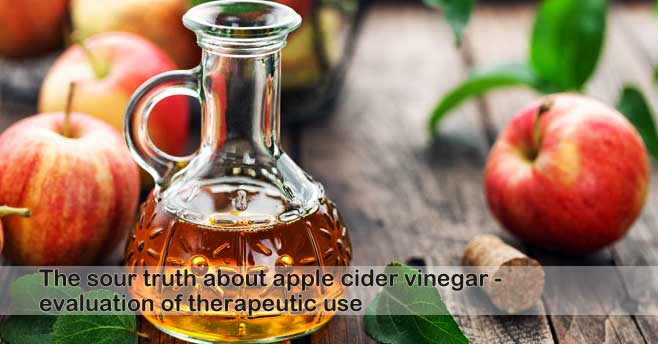The sour truth about apple cider vinegar – evaluation of therapeutic use
Apple cider vinegar is an old folk remedy claimed to be beneficial in treating a long list of ailments. Proponents say that it can cure arthritis, guard against osteoporosis, lower blood pressure and cholesterol, prevent cancer, destroy infection, assist in digestion and weight control, maintain memory, and protect the mind from aging.
Vinegar is said to have been used for medical ailments for at least 10,000 years. The Babylonians first converted wine into vinegar in 5000 BCE using date palms, grapes, and figs, and believed vinegar had exceptional healing properties. Hippocrates is said to have used vinegar as an antibiotic. Samurai warriors supposedly used a vinegar tonic for strength and power. During the U.S. Civil War, soldiers used vinegar to prevent gastric upset and as a treatment for various ailments including pneumonia and scurvy. It was used to treat wounds during World War I.
The name vinegar comes from a French word meaning “sour wine.” It is produced by the action of yeast and bacteria on grains or fruit juices. Vinegars take their name from the material used to make the vinegar, i.e., apple cider vinegar comes from apples, wine vinegar comes from grapes.
Apple cider vinegar is made by crushing apples and squeezing out the liquid. Sugar and yeast are added to the liquid to start the fermentation process, which turns the sugars into alcohol. In a second fermentation process, the alcohol is converted by acetic acid-forming bacteria into vinegar. Acetic acid gives vinegar its sour taste.
“Mother of vinegar” is a term used to refer to the mass of scum that forms on top of cider when alcohol turns into vinegar, or to the cloudy substance that sometimes develops in stored vinegar. It is actually bacteria and yeast cells that have died.
In 1958 Dr. D. C. Jarvis, a “noted Vermont country doctor,” wrote a book entitled Folk Medicine in which he extolled the virtues of vinegar. He claimed that Vermonters knew how to cure migraine headaches, diabetes, chronic fatigue, arthritis, and a variety of other ailments. They used apple cider vinegar.
Among Dr. Jarvis’s many tenets about apple cider vinegar was his advice to pregnant women to drink an apple cider vinegar tonic daily to assure that the infant is born with “an excellent chemical pattern with which to meet its new environment.” He recommended the same tonic for those suffering from arthritis. Believing that apple cider vinegar would destroy bacteria in the digestive tract, he advised those with GI problems to consume a tonic with each meal. He also declared that the regular consumption of an apple cider vinegar tonic would make body fat disappear because the vinegar would cause the fat to be burned instead of stored.
His book quickly sold 500,000 copies and is still in print. Apple cider vinegar is still promoted as one of the chief “natural” remedies for arthritis.
Those who believe that apple cider vinegar has miraculous properties attribute its powers to an abundance of nutrients in the liquid. One company’s sales pitch states, “Each golden drop is a natural storehouse of vitamins and minerals.” Marketers point to the trace minerals, bacteria,. and enzymes present in their product as the ingredients that give apple cider vinegar its curative characteristics. Another company suggests that their apple cider vinegar is superior because it contains pectin, beta-carotene, and potassium in addition to enzymes and amino acids. Apple cider vinegar is also said to contain an abundance of complex carbohydrates and dietary fiber. Dr. Jarvis believed that the healing properties of apple cider vinegar were due in large part to its rich potassium content.
Some New Twists
Apple cider vinegar is sold today by “health food” companies and others who claim it has remedial properties. The claims are similar to those in the past, but some have taken on a modem twist based on more recent medical research.
Marketers contend that the beta-carotene in apple cider vinegar destroys free radicals in the body which are involved in the aging and mutation of tissues and in destroying the immune system. Apple cider vinegar’s beta-carotene is said to be in a “natural, easy to digest form.”
Its use as a remedy for arthritis is based on the notion that acid crystals harden in the joints and tissues which cause the joints to become stiff and the tissues to harden. These acid crystals also cause the body to age prematurely, so the ads state. Apple cider vinegar is supposed is put these acid crystals in solution so they can be flushed from the body.
Producers also claim that apple cider vinegar can lower cholesterol and blood pressure. These assertions are based on the assumption that people naturally crave acids when eating animal proteins in order to lessen the thickening influence of “heavy proteins and fat.” Apple cider vinegar supposedly thins the blood so it can circulate. more freely. Thick blood, they say, puts a strain on the heart and up goes the blood pressure. Another source states that the pectin present in apple cider vinegar works its way through the digestive system, binding to cholesterol and removing it from the body.
Apple cider vinegar is also available in tablet form. One brand is merchandised as a “digestive aid for vegetarians.” The manufacturer of this product alleges that the tablets help acidify the stomach and help digest protein. Another tablet, which contains apple cider vinegar as one of its components, is sold as a fiber supplement and supposedly assists in weight loss. Still other companies add herbs to their apple cider vinegar “so people see relief from even more ailments.”
The rubbery mass of goo called the mother of vinegar” is reputed to have magical healing properties as well. Nibbling on a bit of this moldy slime every day is purported to prevent most infectious diseases and keep germs and parasites from invading the body.
One company’s advertisement for organic, raw, unfiltered, unheated, unpasteurized apple cider vinegar is particularly alarming. This company’s ad maintains that “there is nothing in this wonderful natural apple cider vinegar that can in any way harm your body!” Apparently, they have never heard of the danger of E. coli 0157:H7 in unpasteurized fruit juices. Normally vinegar is too acidic to support bacteria. However, should the acidity weaken (pH reaching 4.6 or higher), then pathogens will survive and grow.
Jogging in a Jug
In 1985, Jack McWilliams, an Alabama farmer, concocted a potion he called “Jogging in a Jug.” It consisted of apple cider vinegar combined with a variety of fruit juices to give it a more appealing taste.
Acetic acid, claimed McWilliams, was lacking in the modem diet, and this deficiency was the root cause of many health problems. He claimed that the potion had cured his arthritis and heart disease, and it could reduce the risk of cancer in the internal organs. McWilliams marketed his product through the media, receiving extensive coverage in small community newspapers and broadcast outlets. He reportedly sold $9 million worth of his potion in one year.
The FDA, however, did not look kindly on Mr. McWilliams’s vinegar product and its advertised claims. The federal government seized the product in 1994 due to the unproven health claims.
In 1995, thousands of bottles of the potion were ordered destroyed because the product was considered an unapproved new drug due to the claims made by the producer. Subsequently, Mr. McWilliams’s company, Third Option Laboratories, Inc., paid the Federal Trade Commission a $480,000 fine to settle charges of false advertising. “Jogging in a Jug” is still on the market today with a new label that meets FDA guidelines.
The Real Story
There is no scientific evidence that apple cider vinegar has any medicinal properties. While the folksy anecdotes from those who claim to have benefited from apple cider vinegar tonics may be amusing to read, they are simply that — anecdotes.
Apple cider vinegar is anything but a storehouse of nutrients. A nutritional analysis of one tablespoon (more than the one or two teaspoons suggested to make a tonic) reveals that the golden liquid contains less than a ram of carbohydrate: minuscule amounts of calcium, iron, magnesium, sodium. copper, manganese, and phosphorus; and a mere 15 mg of potassium. The fiber, vitamin, and amino acid content is zero.
As for the presence of any beneficial enzymes in apple cider vinegar or the “mother,” food scientists doubt that any could thrive in the acid environment of the vinegar. Assuming any were present, though, they would be destroyed in the acid of the stomach when consumed and be of no use to the body.
The Arthritis Foundation calls vinegar a harmless, but unproven, arthritis remedy. It points out that arthritis symptoms come and go, and that a person using an unproven remedy may think a remedy worked simply because they used it at a time when symptoms were going into natural remission. Such is undoubtedly the case for many of the “cures” connected to vinegar.
Beth Fontenot is a nutrition consultant and freelance nutrition writer in Lake Charles, LA. She serves on the adjunct faculty at both McNeese State University in Lake Charles and Lamar University in Qrange, TX.




